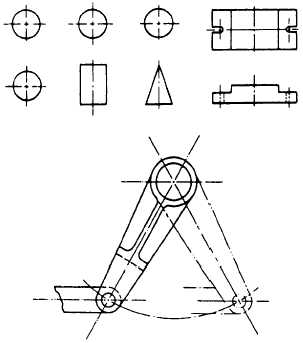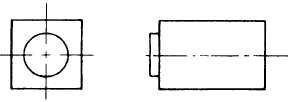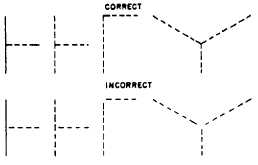should be differentiated from hidden, extension,
dimension, or center lines.
CONSTRUCTION LINES
Usually the first lines that you will use on a
drawing are construction lines. These are the same
lines that you used to lay out your drafting sheet.
They will also be used to lay out the rest of your
drawing. Line weight for construction lines is not
important since they will not appear on your
finished drawing. They should be heavy enough
to see, but light enough to erase easily. A 4H to
6H pencil with a sharp, conical point should be
used. With the exception of light lettering
guidelines, all construction lines must be erased
or darkened before a drawing is reproduced.
CENTER LINES
Center lines are used to indicate the center
of a circle, arc, or any symmetrical object.
(See fig. 3-24.) Center lines are composed of long
and short dashes, alternately and evenly spaced,
with a long dash at each end. They should extend
at least one-fourth in. outside the object. At
intersecting points, center lines should be drawn
as short dashes.
A very short center line may be drawn as a
single dash if there is no possibility of confusing
it with other lines. Center lines may also be used
to indicate the travel of a moving center, as shown
in figure 3-24.
VISIBLE LINES
The visible edge lines of the view are drawn
as solid, thick lines. These include not only the
outlines of the view, but lines defining edges that
are visible within the view. (See fig. 3-25.)
HIDDEN LINES
Hidden edge lines are drawn with short dashes
and are used to show hidden features of an
object. A hidden line should begin with a dash
in contact with the line from which it starts,
except when it is the continuation of an unbroken
line. (See fig. 3-26.)
To prevent confusion in the interpretation
of hidden edge lines, you must apply certain stan-
dard techniques in drawing these lines. A
hidden edge line that is supposed to join a visible
or another hidden line must actually contact the
line, as shown in the upper views of figure 3-27;
Figure 3-25.-Use of visible edge lines.
Figure 3-26.-Use of hidden edge lines.
Figure 3-24.-Use of center lines.
Figure 3-27.-Correct and incorrect procedures for draw-
ing adjoining bidden lines.
3-21








